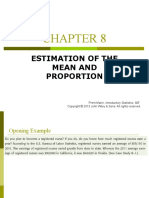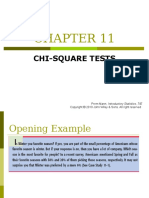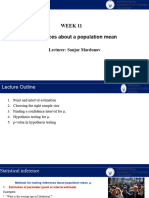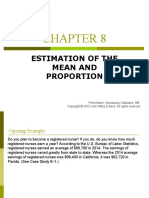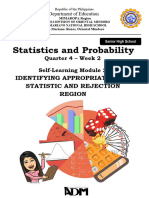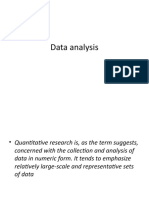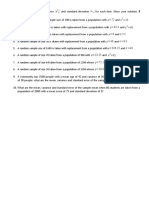Lecture 3
Uploaded by
Wasif Islam SaadLecture 3
Uploaded by
Wasif Islam SaadLecture 3
HYPOTHESIS TESTS ABOUT μ: σ KNOWN
Steps to Perform a Test of Hypothesis
with the Critical-Value Approach
1. State the null and alternative hypotheses.
2. Select the distribution to use.
3. Calculate the value of the test statistic.
4. Determine the rejection and nonrejection
regions.
5. Make a decision.
Prem Mann, Introductory Statistics, 7/E
Copyright © 2010 John Wiley & Sons. All right reserved
Example 9-3
The TIV Telephone Company provides long-distance
telephone service in an area. According to the company’s
records, the average length of all long-distance calls placed
through this company in 2009 was 12.44 minutes. The
company’s management wanted to check if the mean length
of the current long-distance calls is different from 12.44
minutes. A sample of 150 such calls placed through this
company produced a mean length of 13.71 minutes. Assume
that the population standard deviation is of 2.65 minutes.
Using the 2% significance level, can you conclude that the
mean length of all current long-distance calls is different
from 12.44 minutes?
Prem Mann, Introductory Statistics, 7/E
Copyright © 2010 John Wiley & Sons. All right reserved
Example 9-3: Solution
p Step 1: H0 : μ = 12.44 H1 : μ ≠ 12.44
p Step 2: The population standard deviation
σ is known, and the sample size is large (n
> 30). Due to the Central Limit Theorem,
we will use the normal distribution to
perform the test.
Prem Mann, Introductory Statistics, 7/E
Copyright © 2010 John Wiley & Sons. All right reserved
Example 9-3: Solution
p Step 3: α = .02
p The ≠ sign in the alternative hypothesis
indicates that the test is two-tailed
p Area in each tail = α / 2= .02 / 2 = .01
p The z values for the two critical points are
-2.33 and 2.33
Prem Mann, Introductory Statistics, 7/E
Copyright © 2010 John Wiley & Sons. All right reserved
Figure 9.9
Prem Mann, Introductory Statistics, 7/E
Copyright © 2010 John Wiley & Sons. All right reserved
Calculating the Value of the Test Statistic
When using the normal distribution, the
value of the test statistic z for x for a
test of hypothesis about μ is computed as
follows:
x -µ s
z= where s x =
sx n
The value of z for x is also called the
observed value of z.
Prem Mann, Introductory Statistics, 7/E
Copyright © 2010 John Wiley & Sons. All right reserved
Example 9-3: Solution
p Step 4:
s 2.65
sx = = = .21637159
n 150
x - µ 13.71 - 12.44
z= = = 5.87
sx .21637159
Prem Mann, Introductory Statistics, 7/E
Copyright © 2010 John Wiley & Sons. All right reserved
Example 9-3: Solution
§ Step 5: This value of z = 5.87 is greater
than the critical value of z = 2.33, and it
falls in the rejection region in the right
tail in Figure 9.9. Hence, we reject H0
and conclude that based on the sample
information, it appears that the mean
length of all such calls is not equal to
12.44 minutes.
Prem Mann, Introductory Statistics, 7/E
Copyright © 2010 John Wiley & Sons. All right reserved
Example 9-4
The mayor of a large city claims that the average
net worth of families living in this city is at least
$300,000. A random sample of 25 families
selected from this city produced a mean net
worth of $288,000. Assume that the net worths
of all families in this city have a normal
distribution with the population standard
deviation of $80,000. Using the 2.5%
significance level, can you conclude that the
mayor’s claim is false?
Prem Mann, Introductory Statistics, 7/E
Copyright © 2010 John Wiley & Sons. All right reserved
Example 9-4: Solution
p Step 1: H0 : μ ≥ $300,000
H1 : μ < $300,000
p Step 2: The population standard deviation
σ is known, the sample size is small (n <
30), but the population distribution is
normal. Consequently, we will use the
normal distribution to perform the test.
Prem Mann, Introductory Statistics, 7/E
Copyright © 2010 John Wiley & Sons. All right reserved
Example 9-4: Solution
p Step 3: α = .025
p The < sign in the alternative hypothesis
indicates that the test is left-tailed
p Area in the left tail = α = .025
p The critical value of z is -1.96
Prem Mann, Introductory Statistics, 7/E
Copyright © 2010 John Wiley & Sons. All right reserved
Figure 9.10
Prem Mann, Introductory Statistics, 7/E
Copyright © 2010 John Wiley & Sons. All right reserved
Example 9-4: Solution
p Step 4:
s 80,000
sx = = = $16,000
n 25
x - µ 288,000 - 300,000
z= = = -.75
sx 16,000
Prem Mann, Introductory Statistics, 7/E
Copyright © 2010 John Wiley & Sons. All right reserved
Example 9-4: Solution
§ Step 5: This value of z = -.75 is greater
than the critical value of z = -1.96, and it
falls in the nonrejection region. As a
result, we fail to reject H0. Therefore, we
can state that based on the sample
information, it appears that the mean net
worth of families in this city is not less
than $300,000.
Prem Mann, Introductory Statistics, 7/E
Copyright © 2010 John Wiley & Sons. All right reserved
HYPOTHESIS TESTS ABOUT : NOT
KNOWN
Three Possible Cases
Case I. If the following three conditions are
fulfilled:
1. The population standard deviation σ is not
known
2. The sample size is small (i.e., n < 30)
3. The population from which the sample is
selected is normally distributed.
Prem Mann, Introductory Statistics, 7/E
Copyright © 2010 John Wiley & Sons. All right reserved
HYPOTHESIS TESTS ABOUT μ: σ NOT
KNOWN
Three Possible Cases
Case II. If the following two conditions are
fulfilled:
1. The population standard deviation σ is not
known
2. The sample size is large (i.e., n ≥ 30)
Prem Mann, Introductory Statistics, 7/E
Copyright © 2010 John Wiley & Sons. All right reserved
HYPOTHESIS TESTS ABOUT μ: σ NOT
KNOWN
Three Possible Cases
Case III. If the following three conditions are
fulfilled:
1. The population standard deviation σ is not
known
2. The sample size is small (i.e., n < 30)
3. The population from which the sample is
selected is not normally distributed (or its
distribution is unknown).
Prem Mann, Introductory Statistics, 7/E
Copyright © 2010 John Wiley & Sons. All right reserved
HYPOTHESIS TESTS ABOUT μ: σ NOT
KNOWN
Three Possible Cases
Prem Mann, Introductory Statistics, 7/E
Copyright © 2010 John Wiley & Sons. All right reserved
HYPOTHESIS TESTS ABOUT μ: σ NOT
KNOWN
Test Statistic
The value of the test statistic t for the
sample mean x is computed as
x -µ s
t= where s x =
sx n
The value of t calculated for x by using this
formula is also called the observed value
of t.
Prem Mann, Introductory Statistics, 7/E
Copyright © 2010 John Wiley & Sons. All right reserved
Example 9-5
A psychologist claims that the mean age at which
children start walking is 12.5 months. Carol
wanted to check if this claim is true. She took a
random sample of 18 children and found that the
mean age at which these children started walking
was 12.9 months with a standard deviation of .80
month. It is known that the ages at which all
children start walking are approximately normally
distributed. Find the p-value for the test that the
mean age at which all children start walking is
different from 12.5 months. What will your
conclusion be if the significance level is 1%?
Prem Mann, Introductory Statistics, 7/E
Copyright © 2010 John Wiley & Sons. All right reserved
Example 9-5: Solution
p Step 1: H0 : μ = 12.5
H1 : μ ≠ 12.5
p Step 2: The population standard deviation
σ is not known, the sample size is small (n
< 30), and the population is normally
distributed. Consequently, we will use the
t distribution to find the p-value for the
test.
Prem Mann, Introductory Statistics, 7/E
Copyright © 2010 John Wiley & Sons. All right reserved
Example 9-5: Solution
p Step 3: The ≠ sign in the alternative
hypothesis indicates that the test is two-
tailed
s .80
sx = = = .18856181
n 18
x - µ 12.9 - 12.5
t= = = 2.121
sx .18856181
and df = n – 1 = 18 – 1 = 17
.02 < p-value < .05
Prem Mann, Introductory Statistics, 7/E
Copyright © 2010 John Wiley & Sons. All right reserved
Figure 9.11 The required p-value
Prem Mann, Introductory Statistics, 7/E
Copyright © 2010 John Wiley & Sons. All right reserved
Example 9-5: Solution
§ Step 4: For any α greater than .05, we
will reject the null hypothesis. For any α
less than .02, we will not reject the null
hypothesis. For our example, α = .01,
which is less than the lower limit of the p-
value ranges of .02. As a result, we fail
to reject H0 and conclude that the mean
age at which all children start walking is
not different from 12.5 months.
Prem Mann, Introductory Statistics, 7/E
Copyright © 2010 John Wiley & Sons. All right reserved
Example 9-6
Grand Auto Corporation produces auto batteries.
The company claims that its top-of-the-line Never
Die batteries are good, on average, for at least 65
months. A consumer protection agency tested 45
such batteries to check this claim. It found the
mean life of these 45 batteries to be 63.4 months
with a standard deviation of 3 months. Find the
p-value for the test that mean life of all such
batteries is less than 65 months. What will your
conclusion be if the significance level is 2.5%?
Prem Mann, Introductory Statistics, 7/E
Copyright © 2010 John Wiley & Sons. All right reserved
Example 9-6: Solution
p Step 1: H0 : μ ≥ 65
H1 : μ < 65
p Step 2: The population standard deviation
σ is not known and the sample size is large
(n > 30). Consequently, we will use the t
distribution to find the p-value for the test.
Prem Mann, Introductory Statistics, 7/E
Copyright © 2010 John Wiley & Sons. All right reserved
Example 9-6: Solution
p Step 3: The < sign in the alternative
hypothesis indicates that the test is left-
tailed
s 3
sx = = = .44721360
n 45
x -µ 63.4 - 65
t= = = -3.578
sx .44721360
and df = n – 1 = 45 – 1 = 44
p-value < .001
Prem Mann, Introductory Statistics, 7/E
Copyright © 2010 John Wiley & Sons. All right reserved
Figure 9.12 The required p-value
Prem Mann, Introductory Statistics, 7/E
Copyright © 2010 John Wiley & Sons. All right reserved
Example 9-7
Refer to Example 9-5. A psychologist claims that
the mean age at which children start walking is
12.5 months. Carol wanted to check if this claim
is true. She took a random sample of 18 children
and found that the mean age at which these
children started walking was 12.9 months with a
standard deviation of .80 month. Using the 1%
significance level, can you conclude that the mean
age at which all children start walking is different
from 12.5 months? Assume that the ages at
which all children start walking have an
approximately normal distribution.
Prem Mann, Introductory Statistics, 7/E
Copyright © 2010 John Wiley & Sons. All right reserved
Example 9-7: Solution
p Step 1: H0 : μ = 12.5
H1 : μ ≠ 12.5
p Step 2: The population standard deviation
σ is not known, the sample size is small (n
< 30), and the population is normally
distributed. Consequently, we will use the
t distribution to perform the test.
Prem Mann, Introductory Statistics, 7/E
Copyright © 2010 John Wiley & Sons. All right reserved
Example 9-7: Solution
p Step 3: Significance level = .01. The ≠ sign
in the alternative hypothesis indicates
that the test is two-tailed and the
rejection region lies in both tails.
p Area in each tail = α/2 = .01/2 = .005
p df = n – 1 = 18 – 1 = 17
p The critical values for t for 17 df and
.005 area in each tail are -2.898 and
2.898.
Prem Mann, Introductory Statistics, 7/E
Copyright © 2010 John Wiley & Sons. All right reserved
Figure 9.13 The required p-value
Prem Mann, Introductory Statistics, 7/E
Copyright © 2010 John Wiley & Sons. All right reserved
Example 9-7: Solution
p Step 4: s = s = .80 = .18856181
x
n 18
x - µ 12.9 - 12.5
t= = = 2.121
sx .18856181
The value of the test statistic t = 2.121 falls
between the two critical points, -2.898 and
2.898, which is the nonrejection region.
Consequently, we fail to reject H0. As a result,
we can state the difference between the
hypothesized population mean and the sample
mean is so small that it may have occurred
because of sampling error.
Prem Mann, Introductory Statistics, 7/E
Copyright © 2010 John Wiley & Sons. All right reserved
Example 9-8
The management at Massachusetts Savings Bank
is always concerned about the quality of service
provided to its customers. With the old computer
system, a teller at this bank could serve, on
average, 22 customers per hour. The
management noticed that with this service rate,
the waiting time for customers was too long.
Recently the management of the bank installed a
new computer system in the bank, expecting that
it would increase the service rate and
consequently make the customers happier by
reducing the waiting time.
Prem Mann, Introductory Statistics, 7/E
Copyright © 2010 John Wiley & Sons. All right reserved
Example 9-8
To check if the new computer system is more
efficient than the old system, the management of
the bank took a random sample of 70 hours and
found that during these hours the mean number
of customers served by tellers was 27 per hour
with a standard deviation of 2.5. Testing at the
1% significance level, would you conclude that
the new computer system is more efficient than
the old computer system?
Prem Mann, Introductory Statistics, 7/E
Copyright © 2010 John Wiley & Sons. All right reserved
Example 9-8: Solution
p Step 1: H0 : μ = 22
H1 : μ > 22
p Step 2: The population standard deviation
σ is not known and the sample size is large
(n > 30). Consequently, we will use the t
distribution to perform the test.
Prem Mann, Introductory Statistics, 7/E
Copyright © 2010 John Wiley & Sons. All right reserved
Example 9-8: Solution
p Step 3: Significance level = .01. The > sign
in the alternative hypothesis indicates
that the test is right-tailed and the
rejection region lies in the right tail.
p Area in the right tail = α = .01
p df = n – 1 = 70 – 1 = 69
p The critical value for t for 69 df and .01
area in the right tail is 2.382.
Prem Mann, Introductory Statistics, 7/E
Copyright © 2010 John Wiley & Sons. All right reserved
Figure 9.14
Prem Mann, Introductory Statistics, 7/E
Copyright © 2010 John Wiley & Sons. All right reserved
Example 9-8: Solution
p Step 4: s = s = 2.5 = .29880715
x
n 70
x -µ 27 - 22
t= = = 16.733
sx .29880715
The value of the test statistic t = 16.733 is
greater than the critical value of t = 2.382, and
it falls in the rejection region. Consequently,
we reject H0. As a result, we conclude that the
value of the sample mean is too large
compared to the hypothesized value of the
population mean, and the difference between
the two may not be attributed to chance alone.
Prem Mann, Introductory Statistics, 7/E
Copyright © 2010 John Wiley & Sons. All right reserved
You might also like
- Select The Correct Response Correct: Questions Without/pending AnswersNo ratings yetSelect The Correct Response Correct: Questions Without/pending Answers19 pages
- Chapter 9 (Part B) : Hypothesis Tests About The Mean and ProportionNo ratings yetChapter 9 (Part B) : Hypothesis Tests About The Mean and Proportion19 pages
- Estimation of The Mean and Proportion: Prem Mann, Introductory Statistics, 8/ENo ratings yetEstimation of The Mean and Proportion: Prem Mann, Introductory Statistics, 8/E78 pages
- Chi-Square Tests: Prem Mann, Introductory Statistics, 7/ENo ratings yetChi-Square Tests: Prem Mann, Introductory Statistics, 7/E95 pages
- Sampling Distribution and Estimation: Dr. M. Shafiqur RahmanNo ratings yetSampling Distribution and Estimation: Dr. M. Shafiqur Rahman42 pages
- Introduction to Probability and Statistics 13th Edition Mendenhall Solutions Manualinstant download100% (2)Introduction to Probability and Statistics 13th Edition Mendenhall Solutions Manualinstant download53 pages
- Numerical Descriptive Measures: Prem Mann, Introductory Statistics, 7/ENo ratings yetNumerical Descriptive Measures: Prem Mann, Introductory Statistics, 7/E138 pages
- Lecture-11,12 - Chapter 6 - Continuous Random Variables - Normal DistributionNo ratings yetLecture-11,12 - Chapter 6 - Continuous Random Variables - Normal Distribution107 pages
- Chuong 1B - Kiem Soat Sai Lam Trong Kiem Dinh TK (SBE - 11e Ch09b)No ratings yetChuong 1B - Kiem Soat Sai Lam Trong Kiem Dinh TK (SBE - 11e Ch09b)26 pages
- Inferential Statistics For Print Part INo ratings yetInferential Statistics For Print Part I23 pages
- Sampling Distributions: Prem Mann, Introductory Statistics, 9/ENo ratings yetSampling Distributions: Prem Mann, Introductory Statistics, 9/E110 pages
- Nonparametric Methods: Prem Mann, Introductory Statistics, 7/ENo ratings yetNonparametric Methods: Prem Mann, Introductory Statistics, 7/E33 pages
- Slides Prepared by John S. Loucks St. Edward's University: 1 Slide © 2003 Thomson/South-WesternNo ratings yetSlides Prepared by John S. Loucks St. Edward's University: 1 Slide © 2003 Thomson/South-Western44 pages
- Estimation of The Mean and Proportion: Prem Mann, Introductory Statistics, 9/ENo ratings yetEstimation of The Mean and Proportion: Prem Mann, Introductory Statistics, 9/E84 pages
- Introduction to Probability and Statistics 13th Edition Mendenhall Solutions Manual instant download100% (2)Introduction to Probability and Statistics 13th Edition Mendenhall Solutions Manual instant download53 pages
- Chi-Square Test: Prem Mann, Introductory Statistics, 7/ENo ratings yetChi-Square Test: Prem Mann, Introductory Statistics, 7/E33 pages
- 1-Sample T-Test: The Steps For Calculating A Single-Sample T-Test "From Scratch" AreNo ratings yet1-Sample T-Test: The Steps For Calculating A Single-Sample T-Test "From Scratch" Are3 pages
- Free Access to Introduction to Probability and Statistics 13th Edition Mendenhall Solutions Manual Chapter Answers100% (11)Free Access to Introduction to Probability and Statistics 13th Edition Mendenhall Solutions Manual Chapter Answers55 pages
- Hypothesis Tests About The Mean and Proportion: Prem Mann, Introductory Statistics, 7/ENo ratings yetHypothesis Tests About The Mean and Proportion: Prem Mann, Introductory Statistics, 7/E116 pages
- A Review of Basic Statistical Concepts: Answers To Problems and Cases 1No ratings yetA Review of Basic Statistical Concepts: Answers To Problems and Cases 194 pages
- Schaum's Easy Outline of Probability and Statistics, Revised EditionFrom EverandSchaum's Easy Outline of Probability and Statistics, Revised EditionNo ratings yet
- Financial Time Series Analisys For Raizen CompanyNo ratings yetFinancial Time Series Analisys For Raizen Company19 pages
- Full download Principles of Econometrics, 5th Ed. R. Carter Hill pdf docxNo ratings yetFull download Principles of Econometrics, 5th Ed. R. Carter Hill pdf docx41 pages
- Introduction to Econometrics 3rd Edition James H. Stock - eBook PDFpdf download100% (2)Introduction to Econometrics 3rd Edition James H. Stock - eBook PDFpdf download62 pages
- The Bass Model Unscrambling Regression Coefficients For P&QNo ratings yetThe Bass Model Unscrambling Regression Coefficients For P&Q4 pages
- Inferential Statistical Analysis Using Python -No ratings yetInferential Statistical Analysis Using Python -22 pages
- STAT2303 UARK Week 04 Hypothesis TestingNo ratings yetSTAT2303 UARK Week 04 Hypothesis Testing2 pages
- Paired T-Tests: Other PASS Procedures For Testing One Mean or Median From Paired DataNo ratings yetPaired T-Tests: Other PASS Procedures For Testing One Mean or Median From Paired Data13 pages
- Neural Correlates of Learning Accommodation and Consolidation in Generalised Anxiety DisorderNo ratings yetNeural Correlates of Learning Accommodation and Consolidation in Generalised Anxiety Disorder8 pages
- Essentials of Biostatistics in Public Health: Worksheets For Chi-Square TestsNo ratings yetEssentials of Biostatistics in Public Health: Worksheets For Chi-Square Tests3 pages
- Worksheet 4 - Mean and Variance of Sampling DistributionNo ratings yetWorksheet 4 - Mean and Variance of Sampling Distribution2 pages
- What - Are - Confidence Interval and P Value100% (1)What - Are - Confidence Interval and P Value8 pages
- Lecture 8. Confidence Intervals for the MeanNo ratings yetLecture 8. Confidence Intervals for the Mean87 pages
- Handbook of Regression Modeling in People Analytics 1st Edition Keith Mcnulty 2024 Scribd Download100% (4)Handbook of Regression Modeling in People Analytics 1st Edition Keith Mcnulty 2024 Scribd Download50 pages
- Fast Cross-Validation Via Sequential Analysis - PaperNo ratings yetFast Cross-Validation Via Sequential Analysis - Paper5 pages
- Select The Correct Response Correct: Questions Without/pending AnswersSelect The Correct Response Correct: Questions Without/pending Answers
- Chapter 9 (Part B) : Hypothesis Tests About The Mean and ProportionChapter 9 (Part B) : Hypothesis Tests About The Mean and Proportion
- Estimation of The Mean and Proportion: Prem Mann, Introductory Statistics, 8/EEstimation of The Mean and Proportion: Prem Mann, Introductory Statistics, 8/E
- Chi-Square Tests: Prem Mann, Introductory Statistics, 7/EChi-Square Tests: Prem Mann, Introductory Statistics, 7/E
- Sampling Distribution and Estimation: Dr. M. Shafiqur RahmanSampling Distribution and Estimation: Dr. M. Shafiqur Rahman
- Introduction to Probability and Statistics 13th Edition Mendenhall Solutions Manualinstant downloadIntroduction to Probability and Statistics 13th Edition Mendenhall Solutions Manualinstant download
- Numerical Descriptive Measures: Prem Mann, Introductory Statistics, 7/ENumerical Descriptive Measures: Prem Mann, Introductory Statistics, 7/E
- Lecture-11,12 - Chapter 6 - Continuous Random Variables - Normal DistributionLecture-11,12 - Chapter 6 - Continuous Random Variables - Normal Distribution
- Chuong 1B - Kiem Soat Sai Lam Trong Kiem Dinh TK (SBE - 11e Ch09b)Chuong 1B - Kiem Soat Sai Lam Trong Kiem Dinh TK (SBE - 11e Ch09b)
- Sampling Distributions: Prem Mann, Introductory Statistics, 9/ESampling Distributions: Prem Mann, Introductory Statistics, 9/E
- Nonparametric Methods: Prem Mann, Introductory Statistics, 7/ENonparametric Methods: Prem Mann, Introductory Statistics, 7/E
- Slides Prepared by John S. Loucks St. Edward's University: 1 Slide © 2003 Thomson/South-WesternSlides Prepared by John S. Loucks St. Edward's University: 1 Slide © 2003 Thomson/South-Western
- Estimation of The Mean and Proportion: Prem Mann, Introductory Statistics, 9/EEstimation of The Mean and Proportion: Prem Mann, Introductory Statistics, 9/E
- Introduction to Probability and Statistics 13th Edition Mendenhall Solutions Manual instant downloadIntroduction to Probability and Statistics 13th Edition Mendenhall Solutions Manual instant download
- Chi-Square Test: Prem Mann, Introductory Statistics, 7/EChi-Square Test: Prem Mann, Introductory Statistics, 7/E
- 1-Sample T-Test: The Steps For Calculating A Single-Sample T-Test "From Scratch" Are1-Sample T-Test: The Steps For Calculating A Single-Sample T-Test "From Scratch" Are
- Free Access to Introduction to Probability and Statistics 13th Edition Mendenhall Solutions Manual Chapter AnswersFree Access to Introduction to Probability and Statistics 13th Edition Mendenhall Solutions Manual Chapter Answers
- Hypothesis Tests About The Mean and Proportion: Prem Mann, Introductory Statistics, 7/EHypothesis Tests About The Mean and Proportion: Prem Mann, Introductory Statistics, 7/E
- A Review of Basic Statistical Concepts: Answers To Problems and Cases 1A Review of Basic Statistical Concepts: Answers To Problems and Cases 1
- Schaum's Easy Outline of Probability and Statistics, Revised EditionFrom EverandSchaum's Easy Outline of Probability and Statistics, Revised Edition
- Full download Principles of Econometrics, 5th Ed. R. Carter Hill pdf docxFull download Principles of Econometrics, 5th Ed. R. Carter Hill pdf docx
- Introduction to Econometrics 3rd Edition James H. Stock - eBook PDFpdf downloadIntroduction to Econometrics 3rd Edition James H. Stock - eBook PDFpdf download
- The Bass Model Unscrambling Regression Coefficients For P&QThe Bass Model Unscrambling Regression Coefficients For P&Q
- Paired T-Tests: Other PASS Procedures For Testing One Mean or Median From Paired DataPaired T-Tests: Other PASS Procedures For Testing One Mean or Median From Paired Data
- Neural Correlates of Learning Accommodation and Consolidation in Generalised Anxiety DisorderNeural Correlates of Learning Accommodation and Consolidation in Generalised Anxiety Disorder
- Essentials of Biostatistics in Public Health: Worksheets For Chi-Square TestsEssentials of Biostatistics in Public Health: Worksheets For Chi-Square Tests
- Worksheet 4 - Mean and Variance of Sampling DistributionWorksheet 4 - Mean and Variance of Sampling Distribution
- Handbook of Regression Modeling in People Analytics 1st Edition Keith Mcnulty 2024 Scribd DownloadHandbook of Regression Modeling in People Analytics 1st Edition Keith Mcnulty 2024 Scribd Download
- Fast Cross-Validation Via Sequential Analysis - PaperFast Cross-Validation Via Sequential Analysis - Paper










